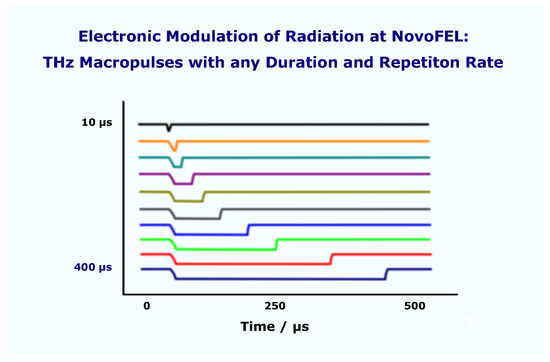Electronic Modulation of THz Radiation at NovoFEL: Technical Aspects and Possible Applications
Abstract
:1. Introduction
2. Materials and Methods
3. Results and Discussion
3.1. Generation of Macropulses at Novosibirsk Free Electron Laser (NovoFEL)
3.2. Possible Applications of Electronic Modulation of THz Radiation at NovoFEL
3.2.1. Control of the Average THz Power in CW Experiments
3.2.2. Formation of Short High-Power THz Macropulses
3.2.3. Lock-in Detection
3.3. Studying the Spin Dynamics Induced by High-Power THz Macropulses of ~30 µs Duration
4. Conclusions
Supplementary Materials
Author Contributions
Funding
Acknowledgments
Conflicts of Interest
References
- Shevchenko, O.A.; Arbuzov, V.S.; Vinokurov, N.A.; Vobly, P.D.; Volkov, V.N.; Getmanov, Y.V.; Gorbachev, Y.I.; Davidyuk, I.V.; Deychuly, O.I.; Dementyev, E.N.; et al. The Novosibirsk free electron laser—Unique source of terahertz and infrared coherent radiation. Phys. Procedia 2016, 84, 13–18. [Google Scholar] [CrossRef]
- Kubarev, V.V. Dynamics of the THz optical discharge, Proceeding of 2014 39th International Conference on Infrared, Millimeter, and Terahertz waves (IRMMW-THz), Tucson, AZ, USA, 14–19 September 2014; IEEE: Washington, DC, USA, 2014; pp. 1–2. [Google Scholar]
- Veber, S.L.; Tumanov, S.V.; Fursova, E.Y.; Shevchenko, O.A.; Getmanov, Y.V.; Scheglov, M.A.; Kubarev, V.V.; Shevchenko, D.A.; Gorbachev, I.I.; Salikova, T.V.; et al. X-band EPR setup with THz light excitation of Novosibirsk Free Electron Laser: Goals, means, useful extras. J. Magn. Reson. 2018, 288, 11–22. [Google Scholar] [CrossRef] [PubMed]
- Marinelli, A.; Ratner, D.; Lutman, A.A.; Turner, J.; Welch, J.; Decker, F.-J.; Loos, H.; Behrens, C.; Gilevich, S.; Miahnahri, A.A.; et al. High-intensity double-pulse X-ray free-electron laser. Nat. Commun. 2015, 6, 6369. [Google Scholar] [CrossRef] [PubMed] [Green Version]
- Ivanov, M.Y.; Nadolinny, V.A.; Bagryanskaya, E.G.; Grishin, Y.A.; Fedin, M.V.; Veber, S.L. Bismuth germanate as a perspective material for dielectric resonators in EPR spectroscopy. J. Magn. Reson. 2016, 271, 83–89. [Google Scholar] [CrossRef] [PubMed]
- Törring, J.T. fsc2. Available online: www.fsc2.org (accessed on 18 September 2019).
- Kubarev, V.V.; Kazakevitch, G.M.; Jeong, Y.U.; Lee, B.C. Quasi-optical highly sensitive Schottky-barrier detector for a wide-band FIR FEL. Free Electron Lasers 2002 2003, 507, 523–526. [Google Scholar]
- Kubarev, V.V.; Serednyakov, S.S. The Measurement and Monitoring of Spectrum and Wavelength of Coherent Radiation at Novosibirsk Free Electron Laser. Presented at the 10th International Workshop on Personal Computers and Particle Accelerator Controls, Karlsruhe, Germany, 14–17 October 2014; pp. 96–98. [Google Scholar]
- Barskaya, I.Y.; Veber, S.L.; Suturina, E.A.; Sherin, P.S.; Maryunina, K.Y.; Artiukhova, N.A.; Tretyakov, E.V.; Sagdeev, R.Z.; Ovcharenko, V.I.; Gritsan, N.P.; et al. Spin-state-correlated optical properties of copper(ii)–nitroxide based molecular magnets. Dalton Trans. 2017, 46, 13108–13117. [Google Scholar] [CrossRef] [PubMed]
- Fedin, M.V.; Veber, S.L.; Bagryanskaya, E.G.; Ovcharenko, V.I. Electron paramagnetic resonance of switchable copper-nitroxide-based molecular magnets: An indispensable tool for intriguing systems. Coord. Chem. Rev. 2015, 289, 341–356. [Google Scholar] [CrossRef]
- Ovcharenko, V.I.; Maryunina, K.Y.; Fokin, S.V.; Tretyakov, E.V.; Romanenko, G.V.; Ikorskii, V.N.; Tretyakov, E.; Romanenko, G. Spin transitions in non-classical systems. Russ. Chem. Bull. 2004, 53, 2406–2427. [Google Scholar] [CrossRef]
- Veber, S.L.; Suturina, E.A.; Fedin, M.V.; Boldyrev, K.N.; Maryunina, K.Y.; Sagdeev, R.Z.; Ovcharenko, V.I.; Gritsan, N.P.; Bagryanskaya, E.G. FTIR Study of Thermally Induced Magnetostructural Transitions in Breathing Crystals. Inorg. Chem. 2015, 54, 3446–3455. [Google Scholar] [CrossRef] [PubMed]
- Kubarev, V.V. Calculation, optimisation, and measurements of optical resonator parameters of the Novosibirsk terahertz free-electron laser. Quantum Electron. 2009, 39, 235–240. [Google Scholar] [CrossRef]
- Kubarev, V.V.; Persov, B.Z.; Vinokurov, N.A.; Davidov, A.V. Optical resonator of powerful free-electron laser. Nucl. Instrum. Methods Phys. Res. Sect. A Accel. Spectrometers Detect. Assoc. Equip. 2004, 528, 199–202. [Google Scholar] [CrossRef]
- Sergeeva, S.; Demidova, E.; Sinitsyna, O.; Goryachkovskaya, T.; Bryanskaya, A.; Semenov, A.; Meshcheryakova, I.; Dianov, G.; Popik, V.; Peltek, S. 2.3 THz radiation: Absence of genotoxicity/mutagenicity in Escherichia coli and Salmonella typhimurium. Mutat. Res. Toxicol. Environ. Mutagen. 2016, 803, 34–38. [Google Scholar] [CrossRef] [PubMed]
- Kevan, L.; Bowman, M.K. Modern Pulsed and Continuous-Wave Electron Spin Resonance; John Wiley and Sons: New York, NY, USA, 1990; p. 440. [Google Scholar]
- Est, A. Continuous-Wave EPR. eMagRes 2016, 5, 1411–1422. [Google Scholar]
- Eaton, G.R.; Eaton, S.S. Rapid-Scan Electron Paramagnetic Resonance. eMagRes 2016, 5, 1529–1542. [Google Scholar]
- Forbes, M.D.E.; Jarocha, L.E.; Sim, S.; Tarasov, V.F. Chapter One—Time-Resolved Electron Paramagnetic Resonance Spectroscopy: History, Technique, and Application to Supramolecular and Macromolecular Chemistry. In Advances in Physical Organic Chemistry; Williams, I.H., Williams, N.H., Eds.; Academic Press: London, UK, 2013; Volume 47, pp. 1–83. [Google Scholar]
- Schnegg, A. Very-High-Frequency EPR. eMagRes 2017, 6, 115–132. [Google Scholar]
- Weber, S. Transient EPR. eMagRes 2017, 6, 255–270. [Google Scholar]
- Veber, S.L.; Fedin, M.V.; Maryunina, K.Y.; Boldyrev, K.N.; Sheglov, M.A.; Kubarev, V.V.; Shevchenko, O.A.; Vinokurov, N.A.; Kulipanov, G.N.; Sagdeev, R.Z.; et al. Influence of Intense THz Radiation on Spin State of Photoswitchable CompoundCu(hfac)2LPr. J. Phys. Chem. A 2013, 117, 1483–1491. [Google Scholar] [CrossRef] [PubMed]
- Telser, J. EPR Interactions–Zero-Field Splittings. eMagRes 2017, 6, 207–234. [Google Scholar]








| FEL | Gain/% | Losses/% |
|---|---|---|
| 1st | 20.0 | 10.3 |
| 2nd | 8.9 | 4.1 |
| 3rd | 19.6 | 9.7 |
© 2019 by the authors. Licensee MDPI, Basel, Switzerland. This article is an open access article distributed under the terms and conditions of the Creative Commons Attribution (CC BY) license (http://creativecommons.org/licenses/by/4.0/).
Share and Cite
Shevchenko, O.A.; Melnikov, A.R.; Tararyshkin, S.V.; Getmanov, Y.V.; Serednyakov, S.S.; Bykov, E.V.; Kubarev, V.V.; Fedin, M.V.; Veber, S.L. Electronic Modulation of THz Radiation at NovoFEL: Technical Aspects and Possible Applications. Materials 2019, 12, 3063. https://doi.org/10.3390/ma12193063
Shevchenko OA, Melnikov AR, Tararyshkin SV, Getmanov YV, Serednyakov SS, Bykov EV, Kubarev VV, Fedin MV, Veber SL. Electronic Modulation of THz Radiation at NovoFEL: Technical Aspects and Possible Applications. Materials. 2019; 12(19):3063. https://doi.org/10.3390/ma12193063
Chicago/Turabian StyleShevchenko, Oleg A., Anatoly R. Melnikov, Sergey V. Tararyshkin, Yaroslav V. Getmanov, Stanislav S. Serednyakov, Evgeny V. Bykov, Vitaly V. Kubarev, Matvey V. Fedin, and Sergey L. Veber. 2019. "Electronic Modulation of THz Radiation at NovoFEL: Technical Aspects and Possible Applications" Materials 12, no. 19: 3063. https://doi.org/10.3390/ma12193063






